

Myths and Legends - Myths and Legends from E2BN. Fairy Tales Collection.com. Folklore and Legend. Myth & Folklore. Courses in druidry, druidry training, druidry courses, druids, druidism. The Hedge Druid: Maps1 – England. This is a gazeteer listing information about the sacred sites we have visited and mapped for subtle energies.
This page covers the sites in England. Contents:- Arbor Low. United_Ancient_Order_of_Druids. The Druid Path - Many Kinds of Druids. United_Ancient_Order_of_Druids. Encyclopedia Mythica: mythology, folklore, and religion. Encyclopedia of Myths. Category:Folklore by nationality. Anglo-Saxon paganism. English folklore. English folklore is the folk tradition which has developed in England over a number of centuries.
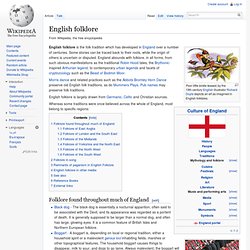
Some stories can be traced back to their roots, while the origin of others is uncertain or disputed. Moai. Moai facing inland at Ahu Tongariki, restored by Chilean archaeologist Claudio Cristino in the 1990s Moai i/ˈmoʊ.aɪ/, or mo‘ai, are monolithic human figures carved by the Rapa Nui people from rock on the Chilean Polynesian island of Easter Island between the years 1250 and 1500.[1] Nearly half are still at Rano Raraku, the main moai quarry, but hundreds were transported from there and set on stone platforms called ahu around the island's perimeter.
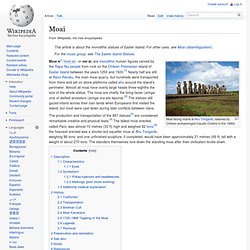
Almost all moai have overly large heads three-eighths the size of the whole statue. The moai are chiefly the living faces (aringa ora) of deified ancestors (aringa ora ata tepuna).[2] The statues still gazed inland across their clan lands when Europeans first visited the island, but most were cast down during later conflicts between clans. Description[edit]
Native American mythology. Coyote and Opossum appear in the stories of a number of tribes.

The mythologies of the indigenous peoples of North America comprise many bodies of traditional narratives associated with religion from a mythographical perspective. Indigenous North American belief systems include many sacred narratives. Such spiritual stories are deeply based in Nature and are rich with the symbolism of seasons, weather, plants, animals, earth, water, sky and fire. The principle of an all embracing, universal and omniscient Great Spirit, a connection to the Earth, diverse creation narratives and collective memories of ancient ancestors are common. Traditional worship practices are often a part of tribal gatherings with dance, rhythm, songs and trance (e.g. the sun dance).
Aztec mythology. Mictlantecuhtli (left), god of death, the lord of the Underworld and Quetzalcoatl (right), god of wisdom, life, knowledge, morning star, patron of the winds and light, the lord of the West.
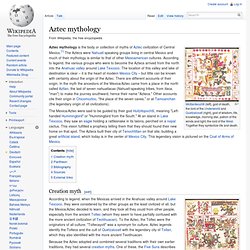
Together they symbolize life and death. Aztec mythology is the body or collection of myths of Aztec civilization of Central Mexico.[1] The Aztecs were Nahuatl speaking groups living in central Mexico and much of their mythology is similar to that of other Mesoamerican cultures. According to legend, the various groups who were to become the Aztecs arrived from the north into the Anahuac valley around Lake Texcoco. The location of this valley and lake of destination is clear – it is the heart of modern Mexico City – but little can be known with certainty about the origin of the Aztec. There are different accounts of their origin. The Mexica/Aztec were said to be guided by their god Huitzilopochtli, meaning "Left-handed Hummingbird" or "Hummingbird from the South.
" Creation myth[edit] Pantheon[edit] Greek Myth in Today's Culture. Uranus (mythology) Irish mythology. Bunworth Banshee The mythology of pre-Christian Ireland did not entirely survive the conversion to Christianity.
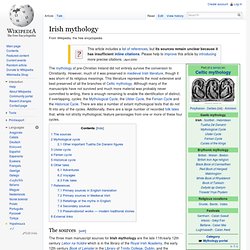
However, much of it was preserved in medieval Irish literature, though it was shorn of its religious meanings. List of Germanic deities. In Germanic paganism, the indigenous religion of the ancient Germanic peoples that inhabited Germanic Europe, there were a number of different gods and goddesses.
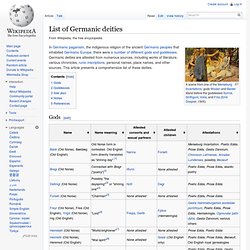
Germanic deities are attested from numerous sources, including works of literature, various chronicles, runic inscriptions, personal names, place names, and other sources. This article presents a comprehensive list of these deities. Gods[edit] Chaos (cosmogony) Godchecker.com - Your Guide To The Gods. Mythology with a twist! Greek Gods Family Tree / Genealogy.
Ludios.org.
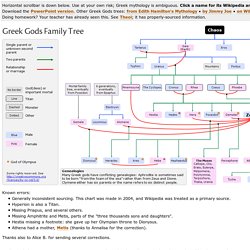
Family tree of the Greek gods. Key: The essential Olympians' names are given in bold font.
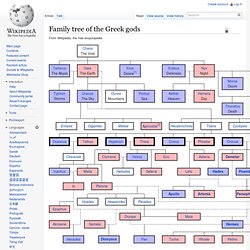
See also List of Greek mythological figures Notes External links Media related to Family trees of Greek mythology at Wikimedia Commons. List of legendary creatures (B) - Wikipedia, the free encyclopedia - StumbleUpon. From Wikipedia, the free encyclopedia Buraq from a 17th-century Mughal miniature.

Here be Dragons! Dragon Art, Dragon Pictures, Dragon Gifts, Dragons for Sale. Mythical and Fantasy Creatures. Mythical Creatures and Beasts. Deitys. Gaia (mythology) The Greek word γαῖα (transliterated as gaia) is a collateral form of γῆ[4] (gē, Doric γᾶ ga and probably δᾶ da)[5] meaning Earth,[6] a word of uncertain origin.[7] R.
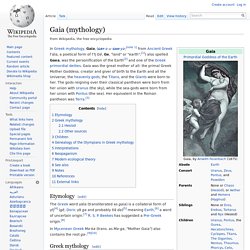
S. P. Beekes has suggested a Pre-Greek origin.[8] In Mycenean Greek Ma-ka (trans. as Ma-ga, "Mother Gaia") also contains the root ga-.[9][10] According to Hesiod, Gaia conceived further offspring with Uranus, first the giant one-eyed Cyclopes: Brontes ("Thunder"), Steropes ("Lightning") and Arges ("Bright");[16] then the Hecatonchires: Cottus, Briareos and Gyges, each with a hundred arms and fifty heads.[17] As each of the Cyclopes and Hecatonchires were born, Uranus hid them in a secret place within Gaia, causing her great pain.
Because Cronus had learned from Gaia and Uranus, that he was destined to be overthrown by his own child, Cronus swallowed each of the children born to him by his Titan sister Rhea. With Gaia's advice[21] Zeus defeated the Titans. In classical art Gaia was represented in one of two ways.